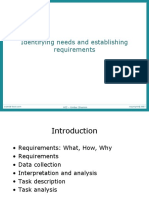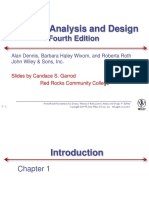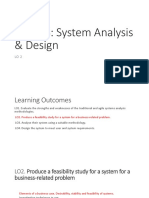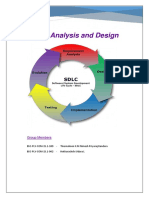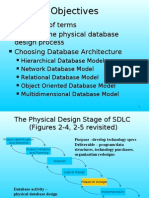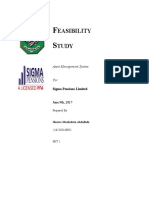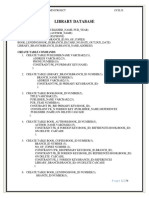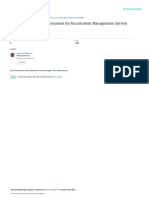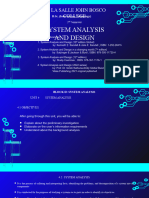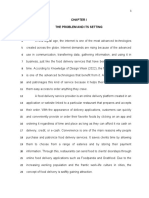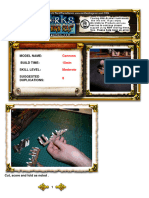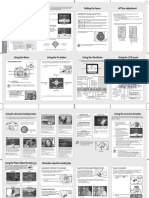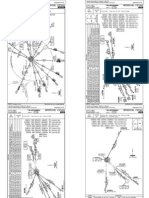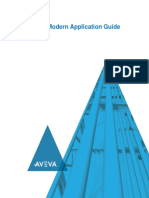Preliminary Investigation
Sources of Requests
Sources of systems projects: User requests Top-management directives System Analysis Information systems department Outside group
�Systems Development Life Cycle
Preliminary Investigation Problem Definition
Implementation Training Conversion Evaluation Maintenance
Ongoing Activities Project Management Feasibility Assessment Documentation Information Gathering.
Analysis Gather data Analyze data Develop requirements
Development Scheduling Programming Testing
Design Preliminary design Detail design
�Preliminary Investigation
Preliminary Investigation
Whatever may be the reason of a request submitted by the Users or Managers to the IS department a system analyst is assigned to make a preliminary investigation. The objective of this activity is to review all requests and identify those proposals that are most beneficial to the organization. But this should be noted that this is neither a designed study nor it includes collection of details to completely describe the business system. Preliminary Investigation object can be achieved in following steps: Request Clarification Feasibility study Estimating Costs and Benefits Request Approvals
�Defining the Problem
Two points that must be agreed upon
The nature of the problem The scope (boundaries) of the problem
Agreeing on the problem helps define the objectives of the system
�Define the project scope and constraints
Project scope Define the range or extent of the project Set project boundaries Constraints Identify conditions, restrictions, or requirements Present vs. future Internal vs. external Mandatory vs. desirable
�What are three basic documents used to summarize technical specifications?
Vendor quotes price(s) for listed product(s)
Identifies product(s) you want
Request for quotation (RFQ)
Vendor selects product(s) that meet(s) your requirements and then quotes price(s)
Request for proposal (RFP)
Request for information (RFI)
Less formal method that uses standard form to request information about product or service
�The System Development Life Cycle
What is the system request?
Assesses feasibility of each alternative solution Recommen ds the most feasible solution for the project Presented to steering committee, which decides how system will be developed
�Preliminary Investigation
Request Clarification
Defining the Scope and Objective of Request:
An analyst has to define for which objective a request for development is submitted.
Conducting the Investigation
This is nothing but the Collection of data / inputs by:
Reviewing internal documents (i.e Organizational Charts, operating procedures etc. Conducting interviews of User, Supervisory Personal and Managers
Identify viable option:
Analyst has to identify the viable option by applying his common sense and intuitions on his investigation.
�Evaluation of Systems Requests
Responsibility for evaluating systems requests: A group of key managers and users Systems review committee Steering committee Computer resources committee Computer policy committee A single individual Typical in smaller companies Must consult with users & managers
�Preliminary Investigation
Feasibility (Possibility) Study
Evaluation of alternative systems through cost and benefit analysis: Technical Feasibility: Hardware and software availability, Technical Guarantee
of Accuracy, Reliability, Easy to Access, Data security, technical capacity to hold data and future expansion.
Economical Feasibility: Evaluation of cost & Benefits expected.
Operational Feasibility: Finding views of workers, employees, customers &
suppliers about the use of new system.
Time Feasibility: Estimation of time to take new system to become operational. Legal feasibility: Testing whether new system will comply financial reporting
requirements & Companys contractual obligations. Social feasibility: Determination of whether a proposed project will be acceptable to the people or not. Management Feasibility: Acceptable to the management or not.
�Preliminary Investigation
Estimating Cost & Benefit
COSTS:
Development Costs: This includes cost of testing, training, start up costs, salary
to designers, acquisition cost of hardware & software.
Operation Costs: This includes operator salary, maintenance costs, etc.
Intangible Costs: Loss of employee productivity, self confidence etc.
BENEFITS:
Tangible Benefits:
Increase in sales / Contribution / Profits Decrease in investment, operating and processing cost. Improved information availability, analysis, Management Decision skill
Intangible Benefits:
Increase in Goodwill / Improved Image of Business
�Preliminary Investigation
Request Approval
The outcome of feasibility study is recommendation of new system proposal. This new information system proposal is to be sanctioned by the higher management in consultation with the department managers. In short, based on the Observation and Findings of the Analyst, selected requests are put up for the approval of management
�The Final Systems Analysis Report
The final procedure in systems analysis is to communicate the consultants systems survey work in a Final Systems Analysis Report . Report should be submitted to steering committee. The report should contain all information needed by management to make a sound decision concerning the proposed design.
�Requirement Analysis & System Analysis
Requirement Analysis and System Analysis
After the selection of a request for development analyst study in depth the Present and Proposed New System. This is the study of weakness & Problems in the present system and management requirements of new system.
This phase of System Development is completed in following step:
Collection of data and facts Analysis of Present System Analysis of Proposed system
�Requirement Analysis & System Analysis
Collection of Data & Facts
Every system is built to meets some set of needs and to assess these needs, the analyst often interact extensively with the people, who will be benefited from the system In order to determine the requirement of those peoples he can use following facts finding techniques:
Record Inspection: This includes the Manuals, diagrams, forms, organizational charts etc. It should be ensured that all documents are accurate & up to date
Questionnaires: These are skillfully drafted group of standard question which can be given to all personal and can be analyze quickly. Interviews: To get a complete picture of problems and opportunities.
Observation: Surprise Visit of users work palace to get a clear picture of users environment.
�Requirement Analysis & System Analysis
Analysis of Present System
Detailed investigation of the present system involves collecting, organizing and evaluating facts about the present system and the environment in which it operates by studying following areas in depth:
Review of Historical Aspects of organization
Analyze Present inputs to the system
Review of all data file maintained irrespective of online or offline Review methods, procedures & data communications Analyze Present outputs of system
Review internal controls
Model the existing physical system and logical system Undertake overall analysis of present system
�Requirement Analysis & System Analysis
Analysis of Proposed System
After each functional area of present system is defined the proposed system specification must be defined. These specification will be based on the strength and weakness of present system. System Specification which should be in conformity with the Project Objective and Areas Covered should be following:
Output / Reports Maintenance of Database Data Inputting Process
Methods and Procedures to show the relationship between Input and Output
Work volume including peak period work volume





